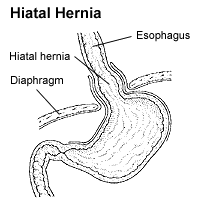Hiatal hernia
A hiatal hernia, also known as hiatus hernia, is a medical condition where abdominal organs, typically the stomach, slip through the diaphragm into the middle compartment of the chest. This condition can lead to gastroesophageal reflux disease (GERD) or laryngopharyngeal reflux (LPR) with symptoms such as acid taste in the back of the mouth and heartburn. Other symptoms may include trouble swallowing and chest pain. Complications can involve iron deficiency anaemia, volvulus, or bowel obstruction. There are two main types of hiatal hernia: sliding and paraesophageal.

Signs and Symptoms
Hiatal hernia is often termed the "great mimic" because its symptoms can resemble many disorders. Symptoms include dull chest pains, shortness of breath due to diaphragm pressure, heart palpitations from vagus nerve irritation, and discomfort when swallowed food "balls up" in the lower oesophagus. Heartburn, chest pain, and pain with eating are also common. In many cases, hiatal hernia does not cause any symptoms, and the pain experienced is often due to gastric acid reflux. In newborns, symptoms like difficulty breathing, fast respiration, and increased heart rate may indicate a Bochdalek hernia.

Causes
The potential causes of hiatal hernia include increased abdominal pressure due to heavy lifting, frequent coughing, hard sneezing, violent vomiting, and straining during defecation. General risk factors include obesity and age-related changes to the diaphragm.
Diagnosis
Diagnosis of a hiatal hernia is typically confirmed through an upper GI series, endoscopy, high-resolution manometry, esophageal pH monitoring, and computed tomography (CT). Each method serves different diagnostic purposes, such as evaluating the size and location of the hernia, analysing the esophageal surface, determining esophageal movements, and diagnosing complications like gastric volvulus.



Classification
Hiatal hernias are classified into four types:
- Type I (Sliding Hiatal Hernia): Part of the stomach slides up through the hiatal opening in the diaphragm. This is the most common type, accounting for 95% of all hiatal hernias.
- Type II (Paraesophageal or Rolling Hernia): The fundus and greater curvature of the stomach roll up through the diaphragm, forming a pocket alongside the oesophagus.
- Type III: Combines elements of both Type I and Type II hernias.
- Type IV: Involves a large defect in the phrenoesophageal ligament, allowing other organs such as the colon, spleen, pancreas, and small intestine to enter the hernia sac.

Treatment
Most people with hiatal hernia experience no significant discomfort and do not require treatment. For symptomatic cases, lifestyle modifications such as elevating the head of the bed, avoiding lying down after meals, and weight loss are recommended.
Medications
Antisecretory drugs like proton pump inhibitors and H2 receptor blockers can help reduce acid secretion. Medications that reduce the lower esophageal sphincter (LES) pressure should be avoided.
Procedures
Oral neuromuscular training has shown tentative evidence of symptom improvement. This treatment has been approved by the UK National Health Service for prescription.
Surgery
Surgery may be considered in severe cases, particularly for large or paraesophageal hernias causing significant symptoms or complications like Barrett's oesophagus. However, surgery carries risks including gas bloat syndrome, dysphagia, dumping syndrome, excessive scarring, and occasionally achalasia. Nissen fundoplication is a common surgical procedure where the gastric fundus is wrapped around the lower oesophagus to prevent herniation and acid reflux. This procedure is often performed laparoscopically with relatively low complication rates and good long-term results.
Epidemiology
The incidence of hiatal hernias increases with age, with approximately 60% of individuals aged 50 or older affected. The majority are sliding hernias, while paraesophageal hernias are less common. Hiatal hernias are most prevalent in North America and Western Europe and rare in rural African communities. Insufficient dietary fibre and high sitting position for defecation may increase risk.

Self-assessment MCQs (single best answer)
What is a hiatal hernia?
Which of the following is a common symptom of a hiatal hernia?
What are the two main types of hiatal hernia?
Which diagnostic method is commonly used to confirm a hiatal hernia?
Which lifestyle modification is recommended for symptomatic hiatal hernia?
What type of medication can help reduce acid secretion in hiatal hernia patients?
Which surgical procedure is commonly performed to treat severe hiatal hernia?
Which type of hiatal hernia is the most common?
What is a potential complication of a hiatal hernia?
In which population is the prevalence of hiatal hernias the highest?
Dentaljuce
Dentaljuce provides Enhanced Continuing Professional Development (CPD) with GDC-approved Certificates for dental professionals worldwide.
Founded in 2009 by the award-winning Masters team from the School of Dentistry at the University of Birmingham, Dentaljuce has established itself as the leading platform for online CPD.
With over 100 high-quality online courses available for a single annual membership fee, Dentaljuce offers comprehensive e-learning designed for busy dental professionals.
The courses cover a complete range of topics, from clinical skills to patient communication, and are suitable for dentists, nurses, hygienists, therapists, students, and practice managers.
Dentaljuce features Dr. Aiden, a dentally trained AI-powered personal tutor available 24/7 to assist with queries and provide guidance through complex topics, enhancing the learning experience.
Check out our range of courses, or sign up now!


